Pheidole vulcan
| Pheidole vulcan | |
|---|---|

| |
| Scientific classification | |
| Kingdom: | Animalia |
| Phylum: | Arthropoda |
| Class: | Insecta |
| Order: | Hymenoptera |
| Family: | Formicidae |
| Subfamily: | Myrmicinae |
| Tribe: | Attini |
| Genus: | Pheidole |
| Species: | P. vulcan |
| Binomial name | |
| Pheidole vulcan Fischer & Fisher, 2013 | |
Pheidole vulcan species has been found in rotten logs, sifted leaf litter, under tree bark and on the lower vegetation in montane rainforest.
Identification
Fischer and Fisher (2013) - Relatively small species (WL major 0.94–1.04 mm, WL minor 0.59–0.73 mm) with relatively short scapes (SI major 46–52, SI minor 96–106) and legs (FI major 58–68, FI minor 104–108) and very abundant standing hairs on mesosoma. Major head posterior half rugoreticulate, submedian hypostomal teeth large, median process absent, promesonotal process barely defined, in profile very high with steep posterior declivity and almost inconspicuous transverse groove, spines relatively long, almost as long as distance between their bases (PSLI 14– 17), postpetiole on average higher than long (LPpI 83–95), without ventral process, but with large lateral process present and about 2.7 times wider than petiole (PpWI 255–276). Minor worker head subrectangular and strongly punctate, clypeus posteriorly usually punctate and with irregular oblique carinae medially, mesosoma mostly strongly punctate with irregular transverse rugulae on pronotal dorsum, spines short-spinose (PSLI 11–16), postpetiole on average almost 1.2 times longer than high (LPpI 114–120).
In its morphology this species is closely related to Pheidole jonas and has been collected in sympatry. While all specimens of P. vulcan are orange in color, the specimens of P. jonas from Mt. Karthala are all dark. More important characters for separating the minor workers of the two species are the shape of the promesonotum in profile, which is less strongly angulate in P. jonas; the amount of sculpture on the clypeus, which is smooth in P. jonas versus posteriorly punctate in P. vulcan; and the significantly more abundant and flexuous standing hairs in P. vulcan in both worker castes. In addition, the postpetiole of P. jonas is relatively longer compared to its height (PpHI 122–163 versus PpHI 114–120) and the height of the petiole (PpLI 52–74 versus PpLI 48–54) than in P. vulcan. The minors of P. vulcan are also similar to those of Pheidole loki; the diagnostic differences are listed under the latter species. The major workers of P. vulcan differ from those of P. jonas by the combination of a high promesonotal process and inconspicuous to weakly concave transverse groove in the first versus a lower process with concave groove in the latter, longer spines (PSLI 14-17 versus PSLI 10-14 in P. jonas) and the postpetiole higher than long (LPpI 83-95) versus usually longer than high (LPpI 90-126).
Keys including this Species
Distribution
Pheidole vulcan is known only from the slopes of the two volcanoes Mt. Karthala and La Grille, at elevations between 995 and 1125 m on Grande Comore and thus is possibly an endemic species of the island.
Latitudinal Distribution Pattern
Latitudinal Range: -11.4758° to -11.827°.
| North Temperate |
North Subtropical |
Tropical | South Subtropical |
South Temperate |
- Source: AntMaps
Distribution based on Regional Taxon Lists
Afrotropical Region: Comoros (type locality).
Distribution based on AntMaps
Distribution based on AntWeb specimens
Check data from AntWeb
Countries Occupied
| Number of countries occupied by this species based on AntWiki Regional Taxon Lists. In general, fewer countries occupied indicates a narrower range, while more countries indicates a more widespread species. |

|
Estimated Abundance
| Relative abundance based on number of AntMaps records per species (this species within the purple bar). Fewer records (to the left) indicates a less abundant/encountered species while more records (to the right) indicates more abundant/encountered species. |

|
Biology
Castes
Images from AntWeb
 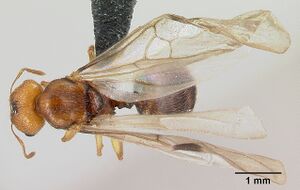   
| |
| Queen (alate/dealate). Specimen code casent0136738. Photographer Erin Prado, uploaded by California Academy of Sciences. | Owned by CAS, San Francisco, CA, USA. |
 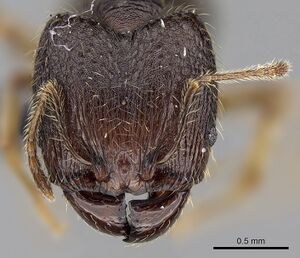 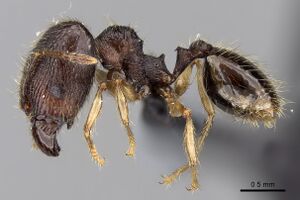 
| |
| Worker (major/soldier). Specimen code casent0136990. Photographer Estella Ortega, uploaded by California Academy of Sciences. | Owned by CAS, San Francisco, CA, USA. |
   
| |
| Holotype of Pheidole vulcan. Worker (major/soldier). Specimen code casent0137234. Photographer Estella Ortega, uploaded by California Academy of Sciences. | Owned by CAS, San Francisco, CA, USA. |
   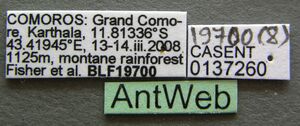
| |
| Worker. Specimen code casent0137260. Photographer Erin Prado, uploaded by California Academy of Sciences. | Owned by CAS, San Francisco, CA, USA. |
   
| |
| Worker (major/soldier). Specimen code casent0137291. Photographer Erin Prado, uploaded by California Academy of Sciences. | Owned by CAS, San Francisco, CA, USA. |
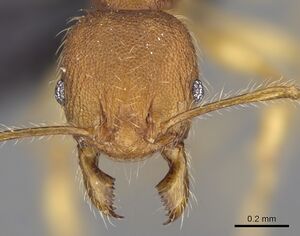   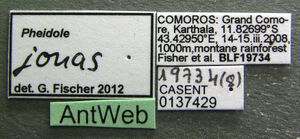
| |
| Paratype of Pheidole vulcan. Worker. Specimen code casent0137429. Photographer Estella Ortega, uploaded by California Academy of Sciences. | Owned by CAS, San Francisco, CA, USA. |
   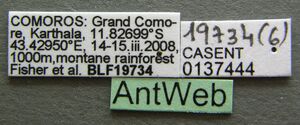  
| |
| Male (alate). Specimen code casent0137444. Photographer Erin Prado, uploaded by California Academy of Sciences. | Owned by CAS, San Francisco, CA, USA. |
Nomenclature
The following information is derived from Barry Bolton's Online Catalogue of the Ants of the World.
- vulcan. Pheidole vulcan Fischer & Fisher, 2013: 349, figs. 26A-F (s.w.) COMOROS.
Unless otherwise noted the text for the remainder of this section is reported from the publication that includes the original description.
Description
Worker
Major (holotype): HW 1.22, HL 1.23, SL 0.62, MDL 0.59, EL 0.14, WL 0.97, PNH 0.47, PNW 0.56, MNH 0.69, PDH 0.36, PTL 0.41, PPL 0.19, PTH 0.25, PPH 0.21, PTW 0.17, PPW 0.45, PSL 0.18, MFL 0.78, MTL 0.55, CI 99, SI 51, MDI 48, EI 11, FI 64, PSLI 15, LPpI 90, DPpI 234, PpWI 262, PpLI 46, PpHI 84.
(n=5): HW 1.15–1.36 (1.26), HL 1.19–1.39 (1.29), SL 0.59–0.62 (0.61), MDL 0.62–0.65 (0.63), EL 0.13–0.15 (0.14), WL 0.94–1.04 (0.99), PNH 0.47–0.50 (0.49), PNW 0.56–0.62 (0.59), MNH 0.71–0.76 (0.73), PDH 0.33–0.37 (0.35), PTL 0.36–0.44 (0.39), PPL 0.18–0.21 (0.20), PTH 0.23–0.27 (0.25), PPH 0.20–0.24 (0.22), PTW 0.15–0.18 (0.17), PPW 0.37–0.48 (0.45), PSL 0.17–0.20 (0.19), MFL 0.75–0.80 (0.78), MTL 0.50– 0.61 (0.58), CI 95–99 (97), SI 46–52 (48), MDI 46–54 (50), EI 10–12 (11), FI 58–68 (62), PSLI 14–17 (15), LPpI 83–95 (89), DPpI 206–235 (225), PpWI 255–276 (267), PpLI 45–56 (51), PpHI 85–96 (90).
Head almost as wide as long (CI 95–99), with weakly convex sides and relatively deep posterior emargination. Mandibles relatively short (MDI 46–54), smooth and shiny, with few weak rugulae near the lateral base. Clypeus smooth, posteromedially with several faint rugulae, continuous with some rugae from frons, usually with two pairs of lateral carinae. Frontal carinae weakly developed, not surpassing anterior third of head, antennal scrobe absent. Frons longitudinally rugose, interspaces superficially punctate. Sides of head longitudinally rugulose and punctate to weakly punctate. Posterolateral lobes irregularly rugoreticulate, with anteriorly weakly to posteriorly superficially punctate interspaces. Scapes relatively short (SI 46–52) with mostly decumbent pilosity and few long erect to suberect standing hairs on outer edge. Submedian hypostomal teeth large and prominent, easily visible in profile view, median process absent. Promesonotal dome high and convex, wide in dorsal view with humeri slightly produced laterally, promesonotal process weakly defined, in profile very high, with almost inconspicuous to shallowly concave transverse groove and strongly defined angle toward steep posterior declivity. Dorsal surface of promesonotum transversely rugulose and weakly to superficially punctate, on highest point partly smooth, lateropronotum similarly sculptured with weak punctures medially, katepisternum superficially punctate to almost entirely smooth and shiny, remainder of mesosoma punctate to weakly punctate. Metanotal groove in profile not impressed, cross-ribs usually short and weakly developed, interspaces superficially sculptured. Spines relatively long-spinose (PSLI 14–17), acute, but shorter than distance between their bases. Metafemur short (FI 58–68), metatibia pilosity mostly decumbent, on outer edge with some subdecumbent to suberect hairs. Petiole in dorsal view very often anteriorly widened with short wing-like lateral processes, postpetiole in profile higher than long (LPpI 83–95), ventral process absent or very shallow, in dorsal view with relatively long lateral processes, at least 2.5 times wider than petiole node (PpWI 255–276). Petiole and postpetiole dorsally superficially punctate, remainder punctate. First gastral tergite smooth and shiny, anteriorly micropunctate. Standing hairs acute, relatively thin, of varying length, and very abundant, on head also with slightly shorter subdecumbent pilosity. Body color orange to light reddish brown, first gastral tergite often lighter colored, other tergites darker, legs dark yellow or orange.
Minor (n= 5): HW 0.46–0.56 (0.53), HL 0.50–0.61 (0.57), SL 0.48– 0.57 (0.54), MDL 0.29–0.35 (0.32), EL 0.10–0.11 (0.11), WL 0.59–0.73 (0.67), PNH 0.22–0.27 (0.24), MNH 0.40–0.50 (0.47), PDH 0.20–0.25 (0.22), PTL 0.21–0.26 (0.24), PPL 0.11–0.14 (0.13), PTH 0.12–0.14 (0.13), PPH 0.10–0.12 (0.11), MFL 0.48–0.60 (0.56), MTL 0.38–0.46 (0.43), PNW 0.30–0.37 (0.34), PTW 0.07–0.09 (0.08), PPW 0.11–0.14 (0.13), PSL 0.06–0.09 (0.07), CI 92–93 (93), SI 96–106 (102), MDI 54–63 (60), EI 18–21 (20), FI 104–108 (106), PSLI 11–16 (14), LPpI 77–86 (81), DPpI 114–120 (117), PpWI 133–169 (153), PpLI 48–54 (52), PpHI 77–86 (81).
Head subrectangular, slightly longer than wide (CI 92–93), sides weakly convex, posterior head margin medially weakly concave, occipital carina not visible in full-face view. Mandibles relatively short (MDI 54–63), smooth. Clypeus posteriorly weakly punctate to punctate, often irregularly and obliquely carinate. Face strongly punctate. Scapes short (SI 96–106), surpassing posterior head margin when laid back by length of ninth funicular segment, with subdecumbent to suberect pilosity and longer suberect to erect hairs along outer edge. Promesonotal outline in profile flatly convex, distinctly elongated, posterior process inconspicuous, bluntly angulate toward high, oblique declivity. Metanotal groove in profile narrow, weakly impressed, with short superficial cross-ribs, interspaces smooth to superficially sculptured. Mesosoma strongly punctate, with the exception of a smooth to superficially sculptured spot on katepisternum, pronotum in addition with strongly to weakly developed, very irregular, transverse rugulae. Propodeal spines acute, short-spinose, distinctly shorter than distance between their bases (PSLI 11–16). Metafemur short (FI 104–108), metatibia with decumbent to suberect pilosity and some longer suberect hairs along outer edge. Postpetiole longer than high (LPpI 114–120), about as long as wide (DPpI 114– 120), and lower than petiole (PpHI 77–86), both segments dorsally smooth to superficially punctate, remainder weakly punctate. Gaster smooth and shiny. Standing hairs very thin and abundant, mostly moderately long, on mesosoma bending medially in oblique dorsal view. Color yellow-orange.
Type Material
Holotype: (major worker), COMOROS, Grande Comore, Karthala, 11.8134 S, 43.4194 E, 1125 m, montane rainforest, sifted leaf litter, collection code BLF19700, 13.iii.2008 (B.L. Fisher et al.) (CASC: CASENT0137234).
Paratypes: (4 major & 10 minor workers) same data as holotype (CASC: CASENT0137211, CASENT0137219, CASENT0137224, CASENT0137225, CASENT0137228, CASENT0137234, CASENT0137236, CASENT0137243, CASENT0137249, CASENT0137251, CASENT0137258– CASENT0137260, CASENT0137270); (3 major & 10 minor workers) Grande Comore, Karthala, 11.8134 S, 43.4194 E, 1125 m, montane rainforest, ex rotten log, collection codes BLF19701, BLF19704, BLF19705, BLF19706, BLF19711, BLF19712, BLF19721, 13.iii.2008 (B.L. Fisher et al.) (California Academy of Sciences: CASENT013531, CASENT0136729, CASENT0136735, CASENT0136741, CASENT0136742, CASENT0136750, CASENT0136753–CASENT0136755; Museum of Comparative Zoology: CASENT0136740); (1 minor worker) Grande Comore, Karthala, 11.8134 S, 43.4194 E, 1125 m, montane rainforest, on low vegetation, collection code BLF19727, 13.iii.2008 (B.L. Fisher et al.) (CASC: CASENT0136746); (1 minor worker) Grande Comore, Karthala, 11.8134 S, 43.4194 E, 1125 m, montane rainforest, under moss, above ground, collection code BLF19730, 13.iii.2008 (B.L. Fisher et al.) (CASC: CASENT0136738, CASENT0136746); (9 major & 8 minor workers) Grande Comore, Karthala, 11.827 S, 43.4295 E, 1000 m, montane rainforest, sifted leaf litter, collection code BLF19734, 14.iii.2008 (B.L. Fisher et al.) (CASC: CASENT0137193–CASENT0137205, CASENT0137206, CASENT0137278, CASENT0137279, CASENT0137291, CASENT0137293, CASENT0137431, CASENT0137442, CASENT0137443, CASENT0137512, CASENT0137515, CASENT0137527, CASENT0137528, CASENT0137592, CASENT0137593); (1 major & 1 minor worker) Grande Comore, Karthala, 11.827 S, 43.4295 E, 1000 m, montane rainforest, ex rotten log, collection code BLF19735, 14.iii.2008 (B.L. Fisher et al.) (CASC: CASENT0135110); (1 major & 1 minor workers) Grande Comore, Karthala, 11.827 S, 43.4295 E, 1000 m, montane rainforest, under tree bark, live tree, collection code BLF19740, 14.iii.2008 (B.L. Fisher et al.) (CASC: CASENT0135229); (1 minor worker) Grande Comore, Karthala, 11.827 S, 43.4295 E, 1000 m, montane rainforest, on low vegetation, collection code BLF19753, 14.iii.2008 (B.L. Fisher et al.) (CASC: CASENT0135237).
Etymology
This new species is named after ‘Vulcan’ the Roman god of fire – and volcanoes – counterpart of the Greek god ‘Hephaestus’ who also was a master craftsman. The name is a noun in apposition and thus invariable.
References
- Fischer, G. & Fisher, B.L. 2013. A revision of Pheidole Westwood (Hymenoptera: Formicidae) in the islands of the Southwest Indian Ocean and designation of a neotype for the invasive Pheidole megacephala. Zootaxa 3683, 301–356.
References based on Global Ant Biodiversity Informatics
- Fischer G. & Fisher B. L. 2013. A revision of Pheidole Westwood (Hymenoptera: Formicidae) in the islands of the Southwest Indian Ocean and designation of a neotype for the invasive Pheidole megacephala. Zootaxa 3683: 301-356

